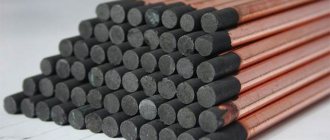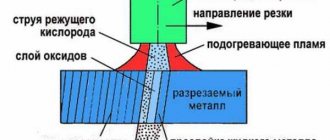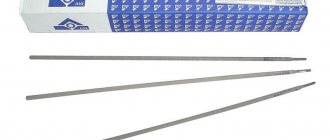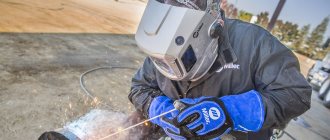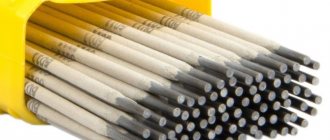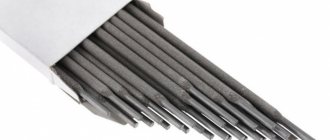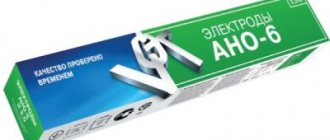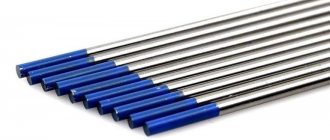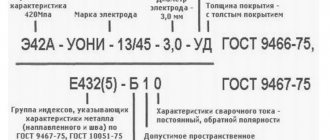All types of electrodes can be combined into two main groups: fusible and non-fusible. Graphite welding electrodes are infusible and are in great demand among users. In the private sphere, the graphic electrode is not used, because There are quite rarely procedures that require the use of such products. Graphite rods for welding are available in a wide range, thanks to which you can choose the product according to the required parameters for various fields. Models characterized by high quality are used in such serious areas as shipbuilding. They are also used in metallurgy plants, foundries, etc. Today, welding the ends of copper wires with a graphite electrode is very popular. Previously, this problem was solved by soldering, but welding products turned out to be much easier. There is no need to use flux or solder, and the contact is reliable.
On a note! Compared to metal analogues, graphite conducts electricity and does not melt, while all its properties and parameters remain unchanged. Today, all kinds of graphite electrodes are produced, the key excellent parameters of which are the tip and length. Also distinguished are ordinary and copper-plated electrodes, which consist of a five percent copper coating designed to improve the characteristics of the metal alloy.
Composition of graphite electrodes and quality properties
Electrodes for welding made of graphite are designed from 2 working parts, between which a gasket is placed.
The main elements may include compressed coal, aluminum, etc. The peculiarity of graphite electrodes is their ability to conduct current without delay and their ability to withstand elevated temperatures. Other advantages of the materials are:
- Affordable price.
- They do not stick to products when heated.
- Resistant to cracking.
- Short heating period.
- To form a stable, full-fledged arc, a current of 5-10 A is enough.
- The connection is heat-resistant and does not deteriorate due to corrosion.
To carry out work using graphite electrodes, inverter-type welding machines can be used.
With an admixture of coal
Graphite electrodes may contain coal or coke with a special content. High-quality products have the correct shape, the surface is free of cracks and defects. They do not crack during welding.
Work using such electrodes is carried out at direct current of direct polarity. The arc turns out to be stable, length - 6-15 mm. To improve properties and expand the scope of application, carbon products can be subjected to graphitization by heat treatment.
With added copper
To weld copper elements, a modification called “pencil” is used. This is a copper-graphite electrode, which is produced in different types:
- Round - suitable for many applications.
- Infinite, used as an economical option.
- Flat - with a square or rectangular cross-section.
- Semicircular - suitable for cutting.
- Hollow - convenient for forming grooves and gouging.
A variety of modifications allows for expansion of the scope of use of products.
Pros and cons of using
The graphite electrode has the following advantages:
- Increased resistance to current influence.
- Good electrical conductivity, ensuring minimal loss of consumables.
- There is no oxidation when the temperature rises, which increases the service life of the electrode.
- There is no need to use special holders when working - simple ones are enough.
Flaws:
- The effect of the products is limited; for use in special conditions, it is necessary to purchase additional materials with different tip shapes.
- The diameter of the rods is from 6 mm, so if it is necessary to make a thin connection, difficulties arise.
When choosing electrodes, one must be guided by the conditions in which they will be used. If the properties of graphite are not suitable for the work being performed, you need to find another option.
Composition and technical characteristics
The electrode consists of 2 main parts, between which an insulating gasket is installed. It consists of oxides of iron, copper, aluminum, etc.
The main parts are made from coke. This is a special composition of compressed coal. Because of this, the carbon content in the metal increases during operation.
Different models of electrodes have different characteristics, which depend on their composition. The main parameters of electrodes of this type are the thickness of the metal being cut, the size of the groove and the current range.
For example, consider the characteristics of EGP/NR electrodes:
- volume density - 1.6 g/cubic. cm.;
- ash admixture - 0.2%;
- resistance - 8 μOhm;
- bending strength - 11 MPa;
- elasticity - 9 GPa;
Electrodes for high carbon steels
- For welding carbon steel
- For high alloy steels
Selecting electrodes and collecting feedback
Structural steel, used in welding metal products for various purposes, is smelted in open-hearth and open-hearth furnaces. As a result of an increase in the percentage of carbon in steel, the strength of the metal may decrease, and the metal also becomes more sensitive to overheating, which makes the welding process more difficult. Also, the effect of oxygen on steel leaves its marks on its strength. By forming oxide inclusions, oxygen makes the steel more brittle. High-carbon steels have a property that causes the metal to become more brittle after exposure to welding temperatures. This process is more pronounced in high-carbon steels than in medium-carbon steels. The possibility of cracks also increases. Therefore, before welding, it is imperative to preheat the product to be welded to a temperature of 350 - 400 degrees Celsius
Subsequent annealing is of greatest importance before the heated metal product cools to a temperature of 20 degrees Celsius
Due to the many features of high-carbon steels, the production of electrodes specially designed for welding with the above types of steels was launched. These are HP-70 electrodes. They are classified as consumable electrodes. The type of coverage is basic. For welding with NR-70 electrodes, direct current of reverse polarity is used. The preferred welding position is down.
The main purpose of NR-70 electrodes is manual arc surfacing of worn ends of conventionally produced rails. They are also used to work with rails made from open-hearth steel and volume-hardened surfaces. HP-70 is used to work with high-carbon steels included in rails, except for rails made using Bessemer steel.
Welding electrodes are made with a diameter of 4 and 5 millimeters. For welding with 4 mm electrodes, you need to use a welding current of 170 - 190 Amps, and for a diameter of 5 mm - 220 - 240 Amps. The composition of the deposited metal with NR-70 electrodes includes molybdenum, silicon, silicon, titanium, chromium, phosphorus, iron, copper, nickel, carbon and sulfur.
The deposition rate of NR-70 electrodes is 9 g/Ah. For surfacing 1 kilogram of metal, approximately 1.6 kilograms of HP-70 electrodes are used. As you can see, the metal spattering of the HP-70 electrodes is quite low. When welding sheet structures made of high-carbon steel with a thickness of 3–4 millimeters, heating the part completely or at the welding site is not necessary.
Carrying out welding work without heating, metal of such thickness will not be subject to cracking and crystallization. When switching to welding thicker sheet metal, it is advisable to heat the product being welded. If you ignore this requirement, the weld may turn out to be of poor quality. Plasmatec electrodes Sandvik electrodes Electrode factories Ano-4t electrodes
Graphite electrodes normal power RP
| units change | ∅ 75-130 mm | ∅ 150-255 mm | ∅ 250-300 mm | ∅ 350-550 mm | ||||||
| FZ | OS | FZ | OS | FZ | OS | FZ | OS | |||
| Resistivity | Electrode | μΩ M | 7,20 | 8,50 |10,00 | 7,50 | 9,00| 10,50 | 7,80 | 9,00| 10,50 | 8,00 | 9,00| 10,50 |
| Nipple | 6,00 | 8,50 | 6,50 | 8,50 | 6,80 | 8,50 | 6,80 | 8,50 | ||
| Tensile strength | Electrode | MPa | 10,50 | 9,80 | 10,80 | 9,80 | 8,40 | 7,80 | 8,40 | 6,40 |
| Nipple | 13,50 | 13,00 | 13,50 | 13,00 | 13,50 | 13,00 | 13,50 | 13,00 | ||
| Elastic modulus | Electrode | Gpa | 9,30 | 9,30 | 9,30 | 9,30 | 9,30 | 9,30 | 9,30 | 9,30 |
| Nipple | 14,00 | 14,00 | 14,00 | 14,00 | 14,00 | 14,00 | 14,00 | 14,00 | ||
| Ash content | Electrode | % | 0,30 | 0,30 | 0,30 | 0,30 | 0,30 | 0,30 | 0,30 | 0,30 |
| Nipple | 0,30 | 0,30 | 0,30 | 0,30 | 0,30 | 0,30 | 0,30 | 0,30 | ||
| Bulk Density | Electrode | g/cm3 | 1,60 | 1,58 | 1,55 | 1,52 | 1,55 | 1,50 | 1,55 | 1,50 |
| Nipple | 1,72 | 1,63 | 1,72 | 1,63 | 1,72 | 1,70 | 1,72 | 1,70 | ||
| (CTE) | Electrode | 10–6/ °C | 2,80 | 2,90 | 2,80 | 2,90 | 2,80 | 2,90 | 2,80 | 2,90 |
| Nipple | 2,80 | 2,70 | 2,70 | 2,70 | 2,70 | 2,80 | 2,70 | 2,80 |
What electrodes are used for underwater welding
Application of tungsten electrodes
Electrodes for welding cast iron
Carbon and graphite rods are practically not used today for home use. Tungsten rods are used to weld non-ferrous metals, aluminum and stainless steel.
Depending on the welding mode in shielding gases, which is determined by such factors as the thickness of the metal, its type, protective atmosphere and others, the type of tungsten rod is selected for use in the appropriate mode.
Classification of tungsten electrodes of foreign production.
| Current welding mode | The purpose of the electrode depending on the type of metal | Electrode color designation | Electrode brand designation |
| Variable | For welding aluminum, magnesium and their alloys | Green | W.P. |
| Constant | For welding low alloy, carbon and stainless steels | Red | WT-20 |
| Constant or variable | For welding steel of any grade | Gray | WC-20 |
| Constant or variable | For welding stainless and alloy steel | Golden | WL-15 |
| Constant or variable | For welding stainless steels | Blue | WL-20 |
| Constant | For welding stainless, carbon and low alloy steel and copper | Dark blue | WY-20 |
| Variable | For welding aluminum and magnesium | White | WZ-8 |
Refractory electrodes of domestic production are marked:
- EVL - lanthanum rods.
- EVI - yttrium rods.
- EHF - tungsten rods. Welding is carried out only on alternating current.
For EVL and EVI markings, welding can be carried out in two modes with the required polarity. They have different color codes depending on the purpose of use. The choice of mode and current depends on the characteristics of the workpiece and metal. For example, copper and stainless steel products are welded using direct current, while aluminum is welded using alternating current.
When welding with non-consumable electrodes, the polarity should be set: direct or reverse. For reverse polarity, set the ground to minus and the holder to positive, and for direct polarity, vice versa. The shape of the welded metal will depend on the choice of polarity mode. The seam will be deep and narrow when direct current and straight polarity are installed. A wide and shallow seam will be obtained by choosing direct current and reverse polarity.
Tungsten rods tend to become dull as welding work progresses and require sharpening. When the electrode length is up to three diameters, the sharpening angle should be maintained at 30 degrees and the tip should be dulled by half a millimeter. To save the length of the tungsten rod, welding work begins by supplying gas and then igniting the arc. For the same purpose, it is strictly forbidden to knock on the workpieces with the tip of the electrode. The arc should be struck on graphite and then transferred to the welding site.
Disadvantages and advantages of welding
Among the advantages of using non-consumable electrodes for arc welding are:
- Minimal deformation in metals after welding due to the minimal heating zone.
- High quality connection.
- Speed of work completion.
- Low barrier to entry.
- Availability of a wide range of materials for welding work.
The disadvantages include:
- Shielding gas is blown out of the welding zone, which makes it difficult to work outdoors in windy weather.
- Before carrying out welding work, high-quality preparation of the metal is required.
- Parts must be cleaned when igniting outside the welding zone.
Advantages and disadvantages
Graphite electrodes have some advantages that are worth mentioning:
- Electrodes are easy to produce because they can be made from leftover rods produced in smelting furnaces.
- The material copes well with high current densities.
- Electrodes conduct electricity well and make the welding process more efficient.
- The material does not oxidize even at high temperatures and can be used for a very long time.
- The rods do not require a special holder for use.
The disadvantages of this type of consumables include:
- They have a narrow specialization and strict requirements for tips.
- The amount of carbon in the metal can increase during welding.
- Electrodes are not thin (minimum diameter 6 mm), which means they cannot be used everywhere.
Application of electrodes
These electrodes consist of crystalline carbon-graphite. It has a gray color and a metallic sheen. It is easy to cut and soft. The rods are used when cutting metal or welding non-ferrous metals. They can also be used for surfacing hard metals.
The melting point of pure carbon is about 3500°C. During operation, this substance does not melt but simply evaporates.
There are no standards by which graphite electrodes are manufactured. They are made from the remains of electrodes from melting furnaces. They are cut and ground. The end of the rod is sharpened at an angle of 60°. Graphite has much lower resistance than coal. This makes it possible to use electrodes with high current.
Let's consider the features of using electrodes:
- Welding is performed by an arc that occurs between a non-consumable electrode and the material. The edges and filler material are heated until they melt. A pool is formed, which, after hardening, forms a seam.
- When working with a graphite electrode, direct current of direct polarity is used. With reverse polarity, the arc becomes unstable and severe carburization of the metal occurs. Reverse polarity can only be used when cutting metal.
- The consumption of graphite rods is very small. They hardly crack during operation. During welding, the electrodes should be set to a short length.
Welding Tips
When welding copper conductors, remember that first of all you need to prepare and clean the surfaces to be welded, and then securely fix them.
Welding of copper wires and busbars is carried out only in a top-down position, since molten copper has increased fluidity. In this case, boron slag flux is used. Another feature of this type of electrode is that the melting process is almost indistinguishable, since evaporation begins almost immediately (electrical coal melts at a temperature of 3800 °C, and evaporates at 4200 °C). The recommended sharpening angle for the ends of carbon rods is 60÷70°, but for welding non-ferrous metals they must be sharpened at an angle of 20÷40°. Sheet copper up to 4 mm thick can be welded without the use of filler rods (but with mandatory flanging of the edges), and over 4 mm - end-to-end with filler material and cutting the edges at an angle of 45°. Brass welding technology requires cutting edges at an angle of 60÷70° with blunting of the ends by 1÷2 mm. Welding is done by immersing the end of the rod, which must be completely enveloped in zinc vapor.
Figure 5 - Brass wires
Working with aluminum
Carbon electrodes are used to connect even aluminum products, which are traditionally considered difficult to weld. Aluminum has low density, significant thermal conductivity and resistance to corrosion.
This metal melts at a temperature of 660 °C, and it combines quite well with oxygen, which is why it is covered with a film of aluminum oxide (chemical formula - Al2O3).
The presence of such a film, as well as the ease of formation of cracks and pores in the weld metal, are the main difficulties encountered when doing this. But the use of carbon electrodes makes it possible to cope with them.
In particular, this is the method used to connect aluminum busbars in electrolysis shops. Tires are traditionally butt welded on a graphite or aluminum backing.
Graphite plates with cutouts opposite the seam are mounted on the sides of the tires. These cutouts make it possible to move the end and start points of the seam beyond the boundaries of the working section.
When welding aluminum surfaces using carbon arc welding, the filler material is wire or rod made of the same metal. To ensure that the oxide film does not interfere and does not affect the result, AF-4A flux, which is a homogeneous, fine white powder, is added to the edges of the seam.
Welding aluminum wires
For welding, you can use an inverter of sufficient power, or you can assemble the device yourself. The device for welding aluminum wires is characterized by an extremely simple design; it can be assembled by a home craftsman with some knowledge in the field of electrical engineering.
Diagram of a device for welding wires.
For assembly you will need:
- step-down transformer from 220 to 12-10 volts,
- diode bridge of sufficient power,
- high capacity electrolytic capacitor,
- pliers for mass clamping,
- electrode holder,
- welding wires with a cross section of 10 mm2.
Such a unit can be powered from the mains or from a generator. Powered by a 24-volt battery is inconvenient: it weighs a lot and discharges quickly.
The wire below the twist is covered with pliers, and a graphite rod is brought to the end of the twist. The electric arc is ignited, and the twist quickly heats up, allowing the ends of the wires to be welded.
When working with such a device, it is very important not to overexpose the electrode to such an extent that the wires begin to melt and drain. This skill comes with experience.
Experienced welders also weld wires using alternating current.
Soldering or welding copper wires - which is better?
The simplest and most effective soldering method is to immerse the contact point in molten solder. For small circuits this method is suitable. But it is not suitable for installing lines made of copper wires. Soldering with tin solders by weight requires skill; beginners cannot cope with such work, and there is a high risk of injury. Connecting wires with your own hands using contact welding is much safer.
Another advantage of welding is that the chemical composition of the wires does not change, and no solder particles get into the alloy. The electrical conductivity of the copper cable at the point of twisting does not change. Welding is faster than soldering; there is no need to pre-tin the contacts or select a soldering iron according to the power of the cable size. There are multi-core cords that cannot be soldered.
Purpose and types of refractory electrodes
The main types of electrodes used for welding work are:
- Tungsten;
- Coal;
- Graphite.
They have different purposes, but belong to the class of non-consumable electrodes.
Carbon rods are used for air-arc cutting of metal and eliminating defects on the surface of products. When using them, welding work is carried out at a current of 580 amperes. Among the coal rods, the following varieties can be distinguished:
- Round VDK (air-arc cutting) grades.
- Round grades SK (welding round).
- Flat grades VAR (air-arc cutting).
Cutting metal using an electric arc and removing the molten metal with a jet of compressed air is called air arc cutting.
Carbon rods have found their application for welding thin-walled structures made of non-ferrous metals and steel, and for welding defects on the surface of cast products.
Carbon rods can be used in the welding process using additives that are placed along the weld line or fed into the weld pool, or without them. They are often used for welding copper wires.
Graphite rods are used for welding aluminum and copper alloys, as well as non-ferrous metals. Compared to coal analogues, this type is more affordable in terms of price parameters. Compared to carbon electrodes, graphite rods withstand temperature better, cut better and have less wear.
Tungsten refractory rods are the most widely used type in home and industrial applications.
They are suitable for welding any metals, even with gas protection. For argon arc welding, tungsten electrodes are available with different compositions:
- Ytrited;
- Lanthanated;
- Thoriated - they are produced with the addition of Thorium, have a low degree of radioactivity, and therefore are not currently used in industry;
- Regular.
They have the form of a rod with a diameter of 1 to 4 millimeters. Due to its refractoriness, its melting temperature is much higher than the temperature of an electric arc, which allows it to weld any metals and alloys. But most often it is used for welding work with aluminum, stainless steel, copper and others.
Production Standards
Requirements for production technology and quality are formulated in GOST 4426-62 . It describes the chemical composition of the product, manufacturing methods, their design and the following typical cross-sectional shapes:
- square;
- round;
- oval;
- rectangular.
A number of diameters are also regulated: from 60 to 550 mm and lengths from 1 to 1.7 m.
The rod should be threaded to attach the nipple end.
The thread can be made with the following profile:
- cone;
- cylinder;
- trapezoid
The standard describes methods and techniques for quality control by the manufacturer, acceptance and shipment of products.
Popular brands
Today, the production of graphite electrodes has gained wide demand; with such products you can carry out welding with your own hands. Let's look at what types of graphite rods exist:
EG are graphitized materials that are produced from coal tar pitch and petroleum coke. Such products are used to work with a current density not higher than 25 A/cm². Some manufacturers produce them together with nipples. Graphite electrodes are often used for electric arc furnaces. The most popular brands are EG1 and EG2, the main difference of which is the resistivity.
graphite electrodes EG1
EGS - for the production of such materials, stone pitch and needle coke are needed. Such graphite electrodes are used for electric arc furnaces, ore thermal structures and refining devices.
EGS electrodes
EGP – impregnated cutting products. They are made from petroleum coke and coal tar pitch. In addition, to achieve a better welding effect, they are additionally impregnated with pitch. It gained wide popularity in the metal foundry industry, in ferroalloy furnaces and electric arc apparatuses.
EGP electrodes
EGSP - in this case, the material consists of needle coke and pitch-impregnated coal tar pitch. Specific resistance is determined by the diameter of the product. There are such models as EGSP 1 and EGSP 2.
EGSP electrodes
Designation and marking
The product designation indicates its type, production method and purpose. The marking includes the first letters of the designation:
- P – impregnated with pitch;
- C – special purpose;
- G – graphitized;
- E – electrode.
So, for example, EGSP-1 means: “graphite electrodes, special purpose, impregnated with pitch.”
Imported manufacturers, such as those from China, use their own brand systems.
Heating Methods
There are several ways to heat consumables. The following devices are most often used at home:
- Soldering iron. Used to perform work characterized by relatively low temperatures. The maximum impact does not exceed 400 Cº. Modern models are equipped with a mechanism for adjusting the temperature. They produce battery-powered soldering irons. Ideal for working with gold and other soft metals.
- Burner. There are gas and plasma models. They use one type of fuel - natural gas, and differ only in the size of the flame. They operate at high temperatures, which makes it possible to solder refractory metals. The disadvantage of burners is the difficulty of adjusting the flame temperature.
Carbon electrodes in home workshops
Copper wire welding diagram.
To work with them in a makeshift manner, a traditional electric arc welding machine is quite suitable. One of the advantageous aspects is a very modest current strength for creating an electric arc due to low thermal conductivity: 3 - 5 A is enough.
An electric carbon arc can be extended to a length of up to 50 mm; it is very easy and comfortable to guide along the future seam due to the slow evaporation of the electrode during welding and the absence of a sticking effect.
Learn welding with carbon electrodes using examples of connecting wires, metal workpieces with thin edges, etc. – a wonderful opportunity to master all skills quickly and efficiently.
Important advice: this type of welding should only be done indoors. The fact is that the arc in such technologies can go out at the slightest breath of wind, not to mention gas flows, magnetic fields and other environmental factors.
It is best to sharpen the electrode at both ends: in this case, you will not need to waste extra time rearranging the consumables in the holder. In addition, the risk of consumable overheating during welding will be reduced.
And with sharpened ends, the holder can rotate 180° when one end overheats, so that the other end can continue working. This will also allow you to save on consumables.
The best option for filler materials is bronze alloy rods. They come with different diameters, which must be selected based on the thickness of the metal workpieces being connected, which is used in calculations using a special formula.
Another type of work in which squares are used is cutting metals.
Arc furnace electrodes
- home
- >
- Library
- >
- Steel production in chipboard
Electrodes used to supply electric current in arc furnaces can be divided into:
- metal (consumable and non-consumable);
- non-metallic (consumable).
Metal consumable electrodes are used in the processes of VAR, VDBP, EBM and PDP. The metal of the electrodes in these processes mainly retains its composition and is only refined. Metal non-consumable water-cooled electrodes are used in some VARs.
Non-metallic electrodes include electrodes used in ore reduction furnaces, indirectly heated arc furnaces and in EAFs.
In ore reduction furnaces, current is usually introduced into the bath using a self-sintering consumable electrode. A self-sintering electrode is a thin-walled steel casing (08KP, 10KP, 10SP), filled with an electrode mass sintered by the heat of the furnace and the current passing through the electrode into a solid block at a level not lower than the contact jaws of the electrode holder.
The electrode mass is a mixture of thermoanthracite, pitch coke, graphitized waste, coke, coal pitch and coal tar with a pitch softening temperature of 50 - 55 oC. The density of such a mixture is 1.35 – 1.45 t/m3.
The electrode mass is loaded into the upper end of the electrode. When loading crushed or liquid electrode mass, its level inside the electrode casing should be 2 - 2.5 m above the upper end of the contact cheek of the current lead.
The diameter of self-sintering electrodes is more than 1000 mm and reaches 2400 mm. The current density in such electrodes ranges from 3.7 to 7.0 A/cm2. Self-sintering electrodes have low mechanical strength. Therefore, they are used only in stationary ovens. In modern arc steel-smelting furnaces, graphite electrodes are used to supply electricity to the working space of the furnace. The annual global production of graphite electrodes exceeds 1 million tons.
Requirements for graphite electrodes - electrodes must have:
- high electrical conductivity;
- low thermal conductivity;
- increased temperature of the onset of oxidation in air;
- low content of ash and especially sulfur;
- high mechanical strength and good machinability.
The raw materials for the production of graphite electrodes are:
- petroleum or pitch coke 75 – 80%;
- coal tar pitch 17 – 20%;
- electrode breakdown up to 10%.
Graphite electrodes for arc steel-smelting furnaces are made cylindrical in the form of solid rods (sections) with a diameter of 100-710 mm and a length of 1000-1800 mm. Arc steel furnaces require a significantly longer electrode length. Therefore, individual sections of electrodes have to be increased to form a “candle” of the required length using special nipples. Each electrode section has threaded holes at both ends into which half a cylindrical or conical nipple is screwed. As necessary, the next section of the electrode is screwed on. Insufficient efforts when screwing up individual sections lead to the formation of additional contact resistance at the points of their connection, heating of these places and breakage of the electrodes due to breaks along the nipple.
One of the significant indicators of the quality of electrodes is the permissible current density (A/cm2), by which one can judge the current carrying capacity of an electrode of a particular diameter. The electrode diameter (cm) is calculated based on the permissible current density.
Permissible current densities of domestic graphite electrodes of the highest grade, brands EGO and EG1, produced in accordance with GOST 4426-71
Such electrodes are used in conventional chipboards, where operating currents do not exceed 45 kA.
For heavy-duty arc furnaces, where currents reach 100 kA, special high-quality graphite electrodes are used, which have low electrical resistance, are denser and stronger, can withstand high current loads and significant mechanical forces that arise during operation of the transformer of a heavy-duty furnace, and are less susceptible to breakdowns. Special electrodes must provide an acceptable current density of 25 - 30 A/cm2.
The technology for producing high-quality electrodes for heavy-duty arc furnaces is quite complex. The required properties of electrodes are obtained by using expensive, high-quality, low-ash charge materials (mainly needle petroleum coke), powerful pressing equipment, impregnation of electrode blanks with pitch binders, and special long-term and complex high-temperature processing (graphitization operations). The high cost of charge materials and high energy consumption determine the very high cost of special graphite electrodes for heavy-duty furnaces ($1500-2000 per 1 ton).
Due to the high cost of graphite electrodes, the cost of electrodes when operating furnaces of normal power for smelting carbon steels is 8% of the cost of steel; when operating heavy-duty furnaces, such costs can exceed 15% of the cost of steel, in some cases reaching 30%. The consumption of graphite electrodes varies within significant limits, which during normal operation of the furnaces is 4 - 8 kg/t (in a well-functioning heavy-duty steel-smelting furnace, the total consumption of electrodes was 4 kg/t of steel).
To improve the technical and economic indicators of metal production, measures to reduce the consumption of electrodes for smelting are of great importance. The consumption of electrodes depends not only on their quality, but also on the design of the furnace, technological and operational factors of smelting, the temperature and nature of the atmosphere of the furnace, the quality of the scrap used, the grade of steel, the use of fuel-oxygen burners, etc.
The main losses of graphitized electrodes during steel melting can be divided into three groups:
- erosion of the electrode end due to evaporation of graphite in the arc combustion zone and dissolution of graphite in the slag;
- oxidation of graphite from the side surface of the electrode;
- broken electrodes and unused electrode stubs.
For various chipboards, these losses are the following values as a percentage of the total losses:
Measures taken to reduce losses of graphite electrodes:
- increasing the length of the arcs and the total time of melting steel in a furnace under current to reduce electrode erosion;
- sealing the furnace and especially the near-electrode space in the roof to prevent interaction with air;
- the use of protective coatings of aluminum, ferrosilicon, silicocalcium and other substances on the side surfaces of graphite electrodes;
- the use of water-cooled combined electrodes (the length of the water-cooled part is from 1/3 to 1/2 of the length of the spark plug;
- use of hollow electrodes.
The use of a protective coating in the form of aluminum made it possible to reduce the consumption of electrodes by 28-42%. The use of a ferrosilicon-based coating reduces consumption by another 6% compared to the use of an aluminum coating.
Typically, when operating an arc furnace, the temperature of the working end of the graphite electrode reaches 4000 ° C (graphite sublimation temperature). In a 100-m furnace, the electrode section subject to oxidation can be 6 m long. If most of them are replaced with a water-cooled metal cylinder, and the rest is made of graphite, then only the graphite section will be oxidized, resulting in the consumption of graphite electrodes due to oxidation of the side surface will decrease.
The use of a water-cooled electrode design allows reducing the consumption of graphite electrodes by 25-30%.
A significant effect can be achieved by combining the method of protective coatings and the use of a water-cooled spark plug design. The consumption of electrodes as a result of oxidation from the surface depends on the total surface area exposed to furnace gases, the chemical composition and speed of movement of gases relative to the electrodes, the surface temperature of the electrodes, the total duration of melting, and the degree of sealing of the furnace. In general, the consumption of electrodes as a result of oxidation from the surface can be reduced by improving the quality of the electrodes, rational organization and technology of melting, reducing the height of the furnace and, consequently, the length of the electrodes, reducing the diameter of the electrode if possible (without increasing the temperature of the electrode), improving the sealing of the furnace, applying protective coatings that prevent the diffusion of oxygen to the electrode surface.
The possibilities for improving the quality of electrodes by increasing the density of the electrode mass have been largely exhausted. Reducing the contact surface of the electrodes with oxidizing gases when reducing the length of the electrodes and the height of the furnace working space is possible only in some cases when working on a heavy charge.
A significant effect can be obtained by improving the sealing of the furnace working space and reducing the amount of oxidizing gases passing through the furnace. To do this, it is necessary to effectively seal the electrode holes in the roof (for furnaces using classical technology).
Reducing the consumption of electrodes in the form of losses due to breakdowns, cinders of electrodes and losses when stopping the furnace for repairs can be reduced by using prepared charge, rational charging, loading and electrical operating modes of the furnace, eliminating charge collapses during melting, and by careful handling of electrodes in the process of transportation and storage. The nipple connection closest to the electrode holder is most susceptible to failure. At high current loads in heavy-duty furnaces, thermal expansion and nipple overload are one of the main causes of electrode failures. To reduce breakages, attempts are being made to increase the strength of the nipple and nipple connections. The option of producing composite electrodes without using nipples is also being tested. In this case, the threaded connections are machined directly from the electrode body and a nipple is not needed. The advantage of this method is a reduction in electrical resistance, a corresponding reduction in thermal loads inside the connection and a reduction in the likelihood of breakdowns during operation of the furnace; The disadvantage is the need for very careful handling of the electrodes, and if they break, the need to re-sharpen the connection elements.
Due to the impossibility of carrying out the necessary preparation of the charge and insufficient development of smelting technology, the consumption of electrodes in most domestic electric furnace shops equipped with heavy-duty furnaces exceeds the average level of electrode consumption in foreign shops. The level of intermediate consumption of electrodes is especially high due to the large number of breakdowns.
in 1910, the use of metal water-cooled electrodes for arc steel-smelting furnaces was proposed. However, the implementation of this idea proved difficult. The all-metal design does not provide protection against short circuits between the metal electrode and the scrap, which poses a potential risk of burnout of the water-cooled electrode and the risk of explosion.
By the beginning of the 70s, a rational solution to the idea of a water-cooled metal electrode was found. The simplest and most reliable of the proposed options turned out to be a composite (combined) electrode, consisting of an upper water-cooled metal cylinder, to the flat lower end of which a consumable graphite electrode is attached. The length of the graphitized section of the combination electrode depends on a number of factors; a minimum length of this section is advisable. The lower the temperature of this area, the longer the service life of the electrode. The consumption of the graphite part of the electrode, among other things, is determined by the oxidation temperature of the graphite mass, the thermal conductivity and porosity of graphite, the length of the graphite section of the electrode, and the temperature distribution along the length of this section.
Typically, when operating an arc furnace, the temperature of the working end of the graphite electrode reaches 4000 °C (graphite sublimation temperature).
As you move away from the working end, the temperature of the electrode decreases and reaches 500 °C at the head of the electrode holder. In a 100-m furnace, the electrode section subject to oxidation can be 6 m long. If most of them are replaced with a water-cooled metal cylinder, and the rest is made of graphite, then only the graphite section will be oxidized, resulting in the consumption of graphite electrodes due to oxidation of the side surface will decrease. In addition, this design solution has a number of other advantages: the likelihood of electrode breakage is sharply reduced; it becomes possible to slightly reduce the diameter of the graphitized area due to the cooling effect of the metal part of the composite electrode; the side surface of the graphitized section of the combined electrode does not need to be subjected to mechanical processing, as a result of which the cost of manufacturing graphitized sections can be reduced; a composite electrode has lower electrical resistance than a graphite electrode, which increases the active power input into the furnace.
By the mid-80s, the most widespread among the proposed designs of combined electrodes were electrodes and “Arc Technologie”. To reduce the consumption of expensive graphite electrodes, the cost of which in (Edmonton) amounted to 33% of all processing costs in electric steelmaking, a design of a composite water-cooled electrode was developed. This design has been used since 1980 at the Edmonton plant on two 80-ton heavy-duty arc furnaces instead of graphite electrodes with a diameter of 500 mm (Fig. 3.1).
The system of composite electrodes includes an upper water-cooled non-consumable section and a lower active graphite section. To reduce mass, the upper section of the electrode is made hollow; water for cooling is supplied through an axial pipeline and discharged through an annular jacket that forms the outer part of a non-consumable cylinder. The smooth, precisely made outer surface ensures good contact with the head of the electrode holder. The non-consumable section of the electrode is connected to the graphite section using a metal water-cooled nipple, which significantly improves the contact of these parts. The graphite electrode can be made with a smaller diameter (since it is cooled through the upper section) and no turning of the outer surface is required. To reduce oxidation of the side surface of the graphitized area, an inexpensive, easily applied, non-conductive refractory coating is used. The permissible length of the residual ends of the graphite sections is at least 50 cm; usually in practice the minimum length of this section can be maintained at 0.7-0.8 m. A new graphite section is inserted between the worn and water-cooled sections of the water-cooled electrode.
The plant's experience has shown that removing worn sections and placing pre-prepared cold sections in their place can be done as quickly as building up conventional graphite electrodes on a furnace. However, the connection outside the furnace is more reliable, the additional savings of electrodes due to the high quality of assembly is 0.5 kg/t of steel. The electrode warehouse is located in the workshop next to the assembly area. Worn electrodes from the furnace are quickly moved to this area by a filling crane, and ready-made new electrodes are delivered to the furnace by the same crane. In the warehouse, used electrodes with a heated working end are quickly connected to a water supply with a small flow rate to prevent deformation of the end cone and avoid steam formation. For this purpose, the cooling system is equipped with quick-release connections.
Figure 3.1
Water-cooled combined electrode: 1 - graphite electrode; 2 — graphite nipple; 3 — tip 4 — inner shell; 5 — metal part of the electrode; 6 — water supply tube; 7 - flange; 8 - water supply; 9 - water drainage
Figure 3.2
Scheme of burning an electric arc on solid (a) and hollow electrodes (b)
Tests of hollow electrodes have shown that the presence of a hole in the electrode has a focusing effect on the arc column. The arc is concentrated at the edge of the inner hole of the hollow electrode, becomes massive, and occupies a strictly vertical position (Fig. 3.2). This, on the one hand, reduces the blowing of the arc from under the electrode, and on the other, increases its shielding by the electrode itself. As a result, the intensity of direct radiation from the electric arc to the roof and walls of the furnace is reduced, helping to increase the durability of the lining and allowing operation at higher voltages. Hollow electrodes contribute to a more stable and quiet burning of the electric arc, reduce voltage fluctuations in the network and the number of current shocks during the melting period. As a result, the power utilization factor of the furnace transformer is improved.
When burning an arc on hollow electrodes with a ratio of hole diameter to electrode diameter = 0.2 - 0.25, compared to working on solid electrodes, the irradiation of the walls decreases by 20-45% and the roof by 28-52%. The greatest effect should be expected when working on electrodes of large diameters (>400 mm), where the central part does not participate in current transmission due to the presence of a surface effect.
- ← Section 3.1
- Section 3.3 →
Graphite electrode for welding
technical characteristicselectrode is easy to cut
As practice shows, welding of wire cores is carried out in distribution boxes. The boxes are located quite high, so you will need to use portable welding equipment for welding.
Industrial devices are used for these purposes, the use of which is advisable in a professional sense. If possible, you can assemble the welding machine yourself. However, for most people, inverter-type devices, which are presented in a large assortment in stores, are perfect. They are compact, mobile, lightweight and also have the ability to adjust the welding current you need.
Types of electrodes for welding copper wire cores
When welding copper conductors, appropriate electrodes must be used. We have already mentioned carbon electrodes. There is also a graphite type of electrodes. Battery rods, brushes of commutator motors and similar products made of graphite can be used as an electrode in household use.
Graphite rods are a good replacement for purchased electrodes, with the only exception that they do not have copper plating, but this can be solved by improving the holder. To do this, it will be necessary to use an alligator clip, both for the electrode and for the ground connection. They will not be as bulky as standard ones, so it will be more convenient for you to work in switchboards. Of course, you will need to take care of additional insulation of the handles.
Graphite and carbon electrodes have a general similarity: both have a melting point 4 times higher than the melting threshold of copper itself. Because of this property, the consumption of electrodes when connecting electrical wiring is very low.
Please note that the electrode heats up to a high temperature instantly, so there is a risk of overheating the material you are welding, which, in turn, can damage the insulation in the cable. The welder needs to know these factors in order to be careful when installing electrical wiring.
Differences between graphite and carbon electrodes
Despite the similarity of graphite and carbon rods when installing wiring, their characteristics differ:
- The first difference is the price. Graphite products are more affordable;
- if the carbon rod is completely black, then the graphite electrode has a gray-dark color with a metallic tint;
- welding using a carbon electrode requires a certain skill from the welder, since the carbon rod creates an arc of enormous temperature, which can lead to the destruction of the welded twist. At the same time, huge temperature indicators occur at low current. Based on this, carbon electrodes will be useful to a welder with a weak welding machine;
- for those who own an inverter device that is equipped with a current regulator, it is better to use graphite rods. When working with them, less skilled craftsman is required. In addition, the connection of wire cores after their use is characterized by greater strength, better quality, and increased resistance to oxidation than after the carbon welding process.
Copper technology
Before welding copper, it is necessary to prepare all equipment and components in advance and check their serviceability. To avoid burns, injuries, and visual impairment, welding work must be performed in a special uniform, gloves, and a protective mask.
Have a fire extinguisher at the ready. Only strict adherence to safe welding rules will allow you to obtain the required result. To weld copper, we will use two types of electrodes - carbon and graphite.
Electrical wires differ in the composition and quality of copper, so it is necessary to select current parameters taking this into account.
If the welding current is selected correctly, the arc will be stable and the electrode rod will not stick. The ability to quickly select current parameters to match the characteristics of the material being welded comes with experience.
Here are approximate current characteristics for different types of wires:
The preparation is complete, you can start welding. First, remove the cable insulation at a distance of 7-10 cm. Then the wires from several cores are twisted.
We carefully trim the resulting twist, leave about 5 centimeters, and place a copper clamp on it. Its function is to remove excess heat. We also connect ground (grounding).
Physico-chemical composition
The main component of a graphite welding electrode is crystalline carbon . The rod consists of two halves, right and left. Between them is laid a dielectric layer containing oxides of iron, creolite clays, copper, aluminum powder and magnesium.
The main layers are made of either solid coking coal or electrode pressed graphite. When graphite welding materials are heated, the carbon content in them increases.
Useful tips
Experts recommend using graphite electrodes without copper plating. This is due to the fact that when the angle burns out, its resistance will drop, which can lead to long contact. This will subsequently affect the quality of the connection.
It is also worth considering the following points:
- Before starting work, the end of the graphite electrode is processed - a recess is formed on it. This will facilitate the formation of a properly shaped adhesive ball.
- As an alternative to factory-made graphite electrodes, you can consider using current collectors used in trolleybuses or battery rods. They are relatively small in size and can be attached to the inverter handle.
- It is mandatory to use protective equipment - a welder's mask (dark glasses), gloves and long sleeves.
Upon completion of welding of copper wires, it is necessary to check the quality of the connection. To do this, they put the maximum permissible load on the network and check whether there is heating on the twist. Only then can the connection be completely isolated.
Production process
Both natural coal extracted from deposits and artificially produced graphite are used as raw materials for production . Various resins serve as binders. Production is divided into the following technological stages:
- extrusion of rod-shaped blanks at high temperature and pressure;
- final forming and cooling;
- thread cutting;
- copper plating
To produce products for a specific purpose, small amounts of metal additives are added to the material.
Types of carbon electrodes
The regulatory framework for the production of domestic carbon electrodes is GOST 10720-75, which contains a description of three types of such products: VDK, VDP, SK, which can be produced either copper-plated or uncoated. Air-arc round air-arcs should be manufactured with a length of 300 mm and four standard sizes in diameter. SK (welding round) - 250 mm long and six standard sizes in diameter. VAF (air-arc flat) - 350 mm long and two sections. At the customer's request, it is allowed to manufacture SK products with a linear dimension of up to 700 mm.
In addition to domestic electrodes, the Russian market offers products from well-known international welding brands and manufacturers from East Asia. The Swedish concern ESAB offers over twenty types of copper-plated carbon electrodes. In addition to products used for direct polarity direct current welding, the ESAB range includes four standard sizes for alternating current welding
And the well-known German manufacturer of welding accessories ABICOR BINZEL, when advertising its products, focuses on the fact that it is made of “synthetic graphite” (i.e.
graphitized carbon). It is likely that these products were pressed from powder obtained from the remains and scrap of metallurgical graphite electrodes.
As a rule, they are rectangular rods with a thickness of 10, 20, 30 or more millimeters and are used for large-scale work at high welding currents: cutting metallurgical scrap, eliminating profits on castings, through cutting of thick metal, etc.
Application and features of work
It is clear that the graphite electrode is used not only for welding wires - its scope of application is much wider. For pre-treatment of metal before welding or other types of processing, cutting metal workpieces, processing metal edges - this type of electrodes is used for all these tasks. The use of graphite allows you to quickly and efficiently cut rivets and pierce elements made of alloy or carbon steel. Special rods are also used for melting steel, cast iron and alloys in electrothermal furnaces. They are made with nipples, which allows them to be connected to each other, which is why the electrode is supplied to the furnace continuously. The use of graphite electrodes for arc cutting of metal reduces the amount of scrap.
Graphite electrodes are also used in the following processes:
- welding of non-ferrous metal products;
- welding of defects obtained during casting;
- welding of thin-sheet metal elements;
- surfacing of carbide parts to the base.
Work with a graphite electrode can also be carried out with filler material. A rod of material used as a filler material can be fed during the welding process or placed in advance at the location of the seam.
It must be remembered that working with this type of electrodes has its own characteristics. During long-term welding, so that the rod material is not consumed too quickly and the arc is stable, a minus must be applied to the electrode (that is, straight polarity must be used). External factors have a significant impact on arc stability. The efficiency when working with graphite is lower compared to consumable electrodes. The joints obtained as a result of welding are not very ductile, and the appearance of voids cannot be ruled out. The work itself, if a carbon or copper-graphite rod is used, differs significantly from welding with conventional electrodes, so only experienced personnel should be allowed to perform critical tasks.
general characteristics
You can choose based on different criteria and for different areas. In shipbuilding, as well as other important areas, products with high quality indicators are used.
They are also used in metallurgy, foundry fields and the like. It is now common to weld copper wires using a graphite rod.
Welding products is a simpler method than outdated soldering. When welding, you do not need to use flux and solder, and the contact is more reliable.
"Good to know. Graphite is a good conductor of electricity, does not melt, and at the same time retains its properties and criteria, unlike metal analogues.
Nowadays, graphite electrodes have a wide range; their main difference is the length and tip. There are also ordinary and copper-plated electrodes consisting of a 5% copper coating, the function of which is to improve the properties of metal alloys.”

